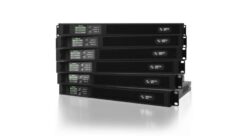
TOA Electronics NX-100
Sep 1, 2004 12:00 PM,
By John McJunkin
TOA Electronics NX-100
The Internet is one of the most important and significant developments in human history, and audio transmission has been an oft-touted use of the medium. There are numerous mechanisms that allow users to get audio from point A to B over the Internet, but many are complicated and unwieldy. There are thousands of radio stations online, but the idea of using the Internet as a transmission line for private communications or networked distribution is relatively uncharted territory. TOA Electronics has introduced the NX-100 network audio adapter, which is a no-muss, no-fuss solution for the transmission of high-quality real-time audio and control signals in the form of serial data over networks using the IP protocol. This black-box system is a welcome and useful way to get sound (and other important data) where you need it.
IP ADVANTAGE
A major advantage of this scheme is that your network (or even the Internet itself) replaces the dedicated lines that are normally required. In the past, dedicated lines were a must for the transmission of high-quality audio, ultimately to be supplanted by Switch56 and ISDN. Although ISDN is still very much a happening thing, time and technology march on, and TOA’s solution brings some advantages. ISDN requires data compression in order to accomplish transmission of high-quality audio, but the NX-100 system can actually send and receive uncompressed digital audio. To be fair, most of the NX-100’s modes of operation do use data compression, but if the available bandwidth is sufficient, 50 Hz to 14 kHz audio bandwidth can be transmitted and received with no data compression whatsoever, yielding what most would describe as FM radio quality, albeit without the digital artifacts associated with lossy compression schemes. If FM quality is not necessary, two lower-quality modes are available, one with a 50 Hz to 7 kHz audio bandwidth (essentially AM radio quality) and one with 50 Hz to 3.4 kHz (essentially telephone quality with extended low end). One caveat is that each unit provides a single channel of audio, so stereo is not possible. It also appears that using two parallel systems to accomplish stereo would be tricky, if not downright impossible.

Regardless of the mono limitation, the NX-100 has other advantages. The broadcast capabilities are powerful. A single transmitted signal can be sent to as many as 64 receiving units. There are myriad applications that could benefit from this. Paging systems, messaging, and background music for airports, transit systems, or even retail and grocery store chains are obvious applications. Security also comes to mind. Many security companies now use microphones placed like security cameras to confirm unauthorized entry. This is an elegant use of the NX-100’s bidirectional operation. During business hours, music and messages can be broadcast to numerous stores in the chain while enabling “listening in” in the event of an after-hours break-in. The NX-100 also simultaneously transmits RS-232 serial data for control or telemetry, not to mention contact closures (which can be programmed to be momentary or latched). This type of command and control surpasses the average ISDN system.
Another major distinction is the peace of mind associated with having black boxes handling most of the heavy lifting. Many software-only solutions are available, but many computers are already overtaxed as it is, and adding the chores associated with transmitting and receiving high-quality audio unfortunately bogs the system down even more. If people need seamless, uninterrupted operation, most are not going to trust a software-only solution, particularly if it exists on a machine that is not dedicated to that purpose. The NX-100 handles all that, leaving your computer to do what you need it for.
LITTLE BLACK BOX
The NX-100 is a half-rack-size box with a front panel about as simple as it gets. On the left are LED indicators for link/activity (LNK/ACT) and full-duplex/collision (FD/COL). On the right are LED indicators for broadcast operation or flash memory operation (Status) and transmission error (Error), as well as an LED that is lit continuously during normal operation and flashes at failure (Run). A recessed button that requires a slender implement to press restarts the unit. In the lower left-hand corner of the panel is the unit’s unique MAC address, which the user must know for operation. The rear panel features the unit’s connections, including both AC and DC power inputs. A 10/100Base-T network connection terminal enables Ethernet linkup. Next to that is a standard 9-pin D-sub for the unit’s RS-232 capabilities. Farther to the right is the NX-100’s control input and output terminals, allowing as many as eight contacts to be controlled remotely. The 0 dB/600ž balanced audio input/output terminal resides just to the right of that. All the I/O is represented with connectors intended for wiring by the user. An Input Volume knob is also present, along with a switch that determines line or mic level input.
WIRED FOR SOUND
Configuration of the boxes through a cross-connect cable was pretty simple business. I test-drove only two boxes, but TOA’s software enables control of dozens of NX-100s and lets you make decisions about the quality of the audio transmission, the pattern of broadcast and reception, and the effect of contact closures as initiated from afar. The boxes can connect with each other over LAN or the Internet and through a single Ethernet cable. Each box also contains a Web server, which allows you to access and configure the unit directly from your Internet browser. The audio quality is good, and latency is not a huge issue. These boxes are not going to be used in live sound, for instance, to replace audio drive lines. The typical application is the distribution of audio to multiple locations, in which case a bit of latency (as little as 20 ms) is simply not an issue.
Although there are numerous ways to transmit and receive audio at reasonable levels of quality over the Internet, the reliability of software-only solutions is always at question. TOA’s NX-100 gives the user the peace of mind of having black boxes to reliably convert audio to packets, transmit them, receive them, convert them back, and provide that same audio on the other end. Moreover, the NX-100 uses multiple error-correction schemes to preserve the continuity and quality of your audio stream. Your computer remains utterly untaxed and free to do what you bought it for. If you need stereo, this is not your solution, but the intention of the product is to distribute audio to multiple locations, and the obvious applications simply do not require stereo. If audio distribution and control and telemetry are important needs of your organization, I strongly recommend consideration of the NX-100.
John McJunkinis the principal of Avalon Audio Services in Phoenix and engages in consulting for both studios and live sound applications.
PRODUCT SUMMARY
Company: TOA Electronics www.toaelectronics.com
Product: NX-100
Pros: Simple, elegant Internet audio/data distribution
Cons: Mono operation only
Applications: Audio distribution
Price: $1,590
SPECIFICATIONS
Power Source 24 VDC plug-in screw connector or optional AC adapter (AD-246)
Current Consumption 200 mA (DC operation)
Audio Input (1) balanced channel (isolated transformer) -58 dB to 0 dB (0 dB=1V), switchable between mic and line level, also continuously variable; 2 kW impedance
Audio Output (1) balanced channel (isolated transformer) plug-in screw connector; 600W impedance
Frequency Response 50 Hz-3.4 kHz (telephone quality); 50 Hz-7 kHz (AM quality); 50 Hz-14 kHz (FM quality)
Distortion <0.3% @1 kHz, when sampling frequency @ 32 kHz
Control Input (8) channels; plug-in screw connector; no-voltage make contact input; 12 VDC open voltage; 10 mA short-circuit current
Control Output (8) channels; plug-in screw connector; open collector output; 30 VDC withstand voltage; 50 mA maximum control current
Network I/F 10Base-T/100Base-TX, autonegotiation
Network Protocol TCP/IP, UDP, HTTP, RTP audio packet
Transmission System Unicast (as many as 4 simultaneous transmissions); multicast (as many as 64 simultaneous transmissions)
Operating Temperature 0° C to 50° C (0° C to 40° C with AC adapter)
Finish Steel plate, black, 30 percent gloss (rackmounting brackets available)
Dimensions (H × W × D) 1.81 × 8.27 × 7.4 inches
Weight 2.65 lb.










